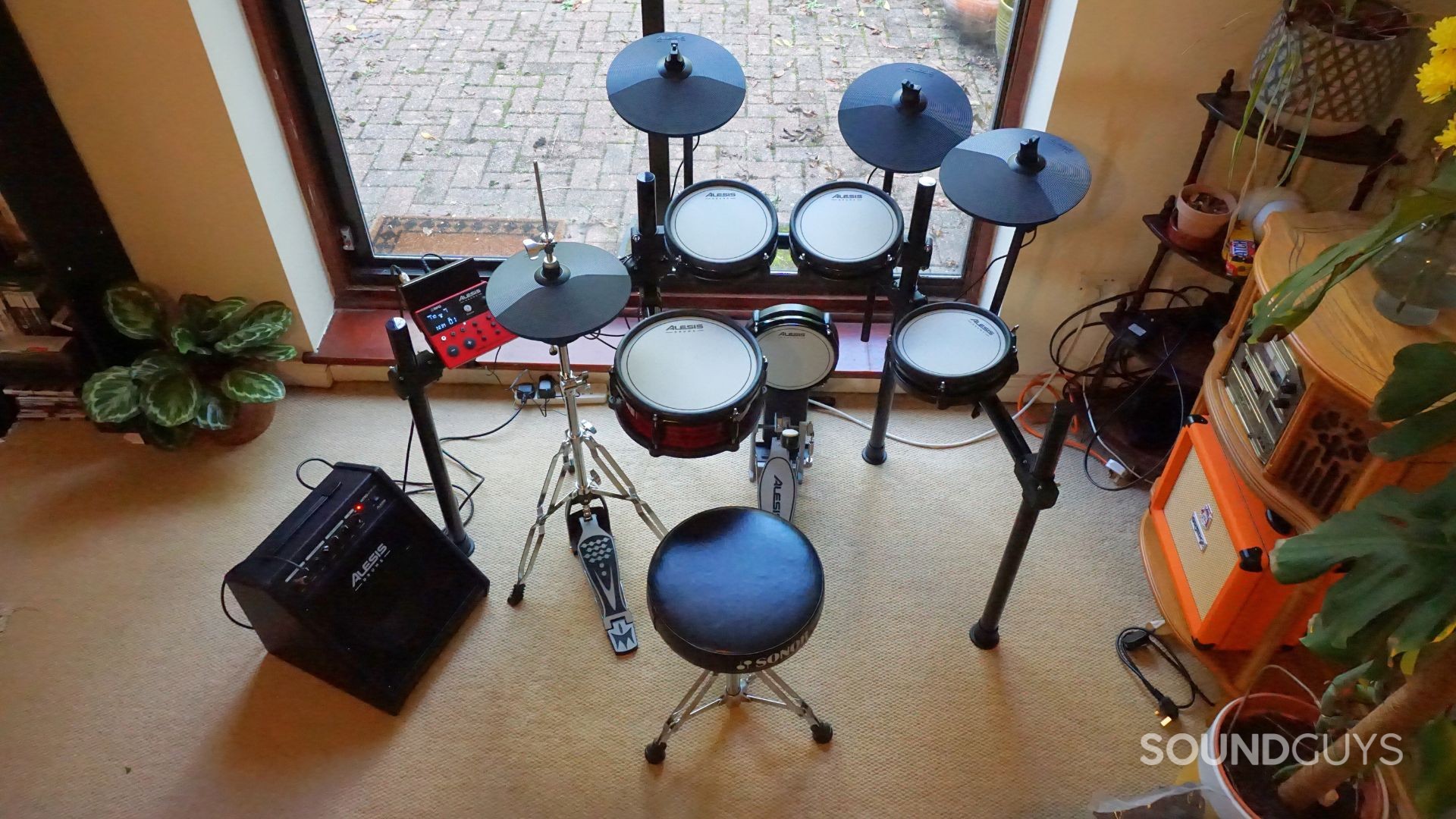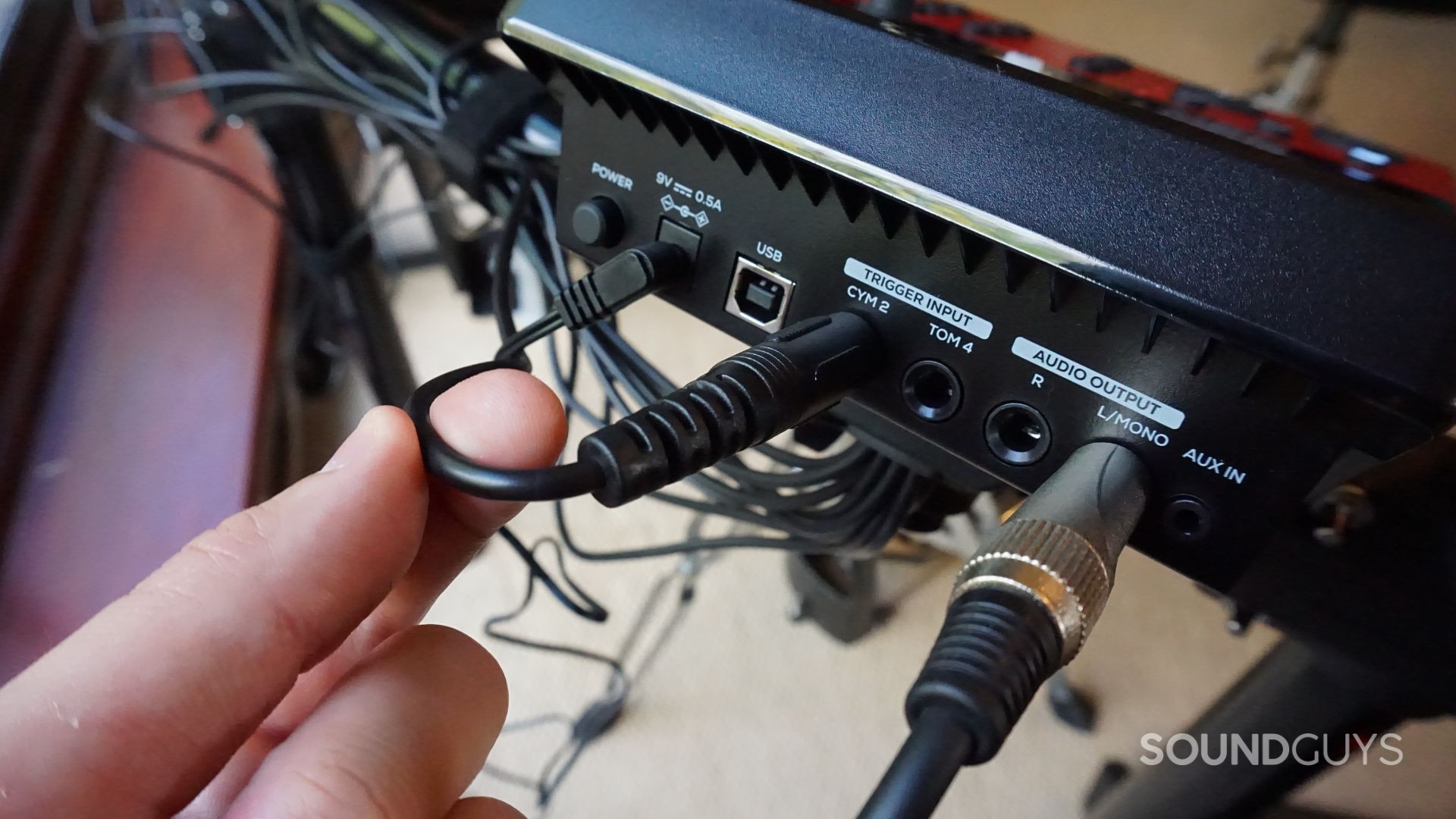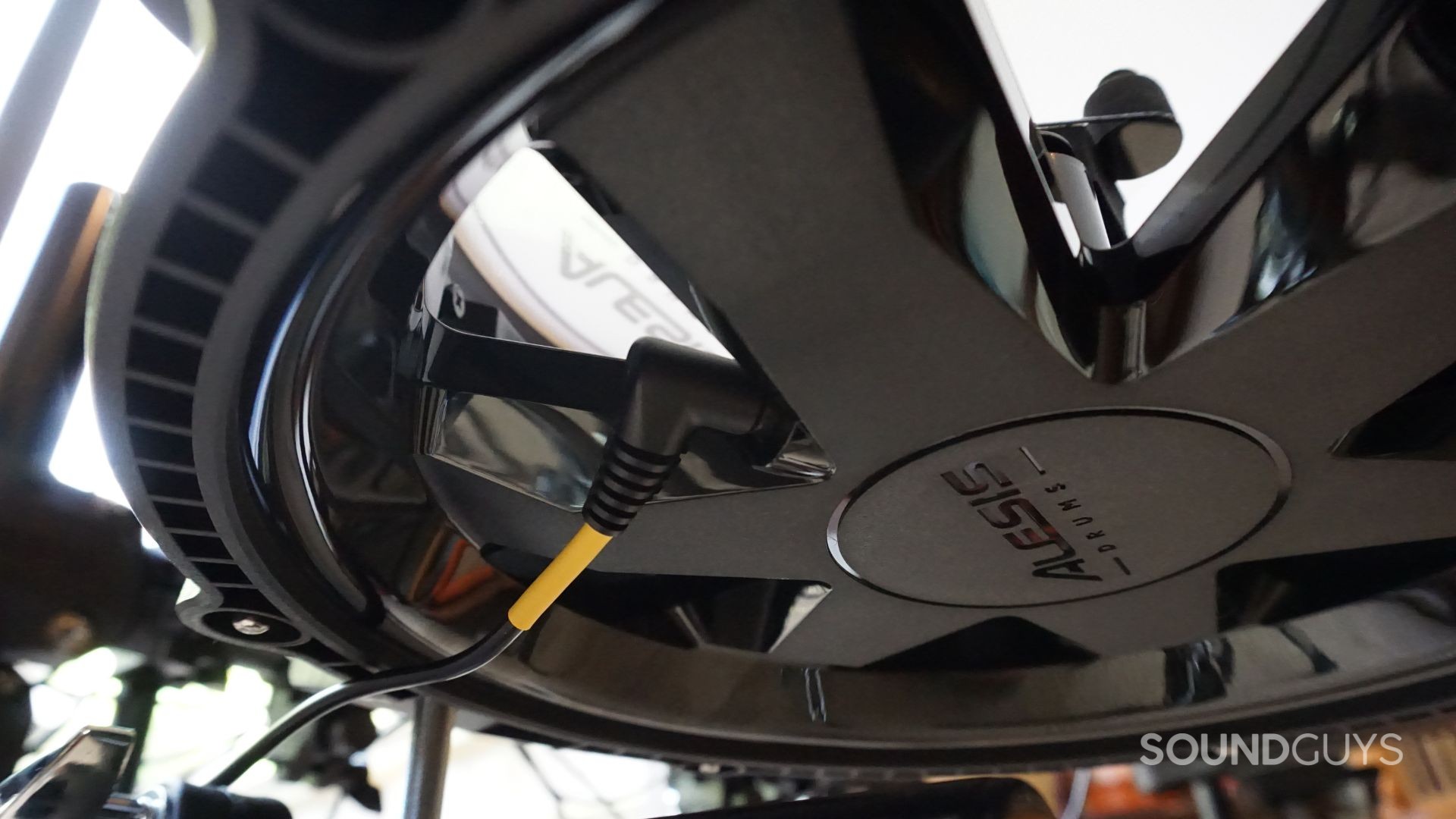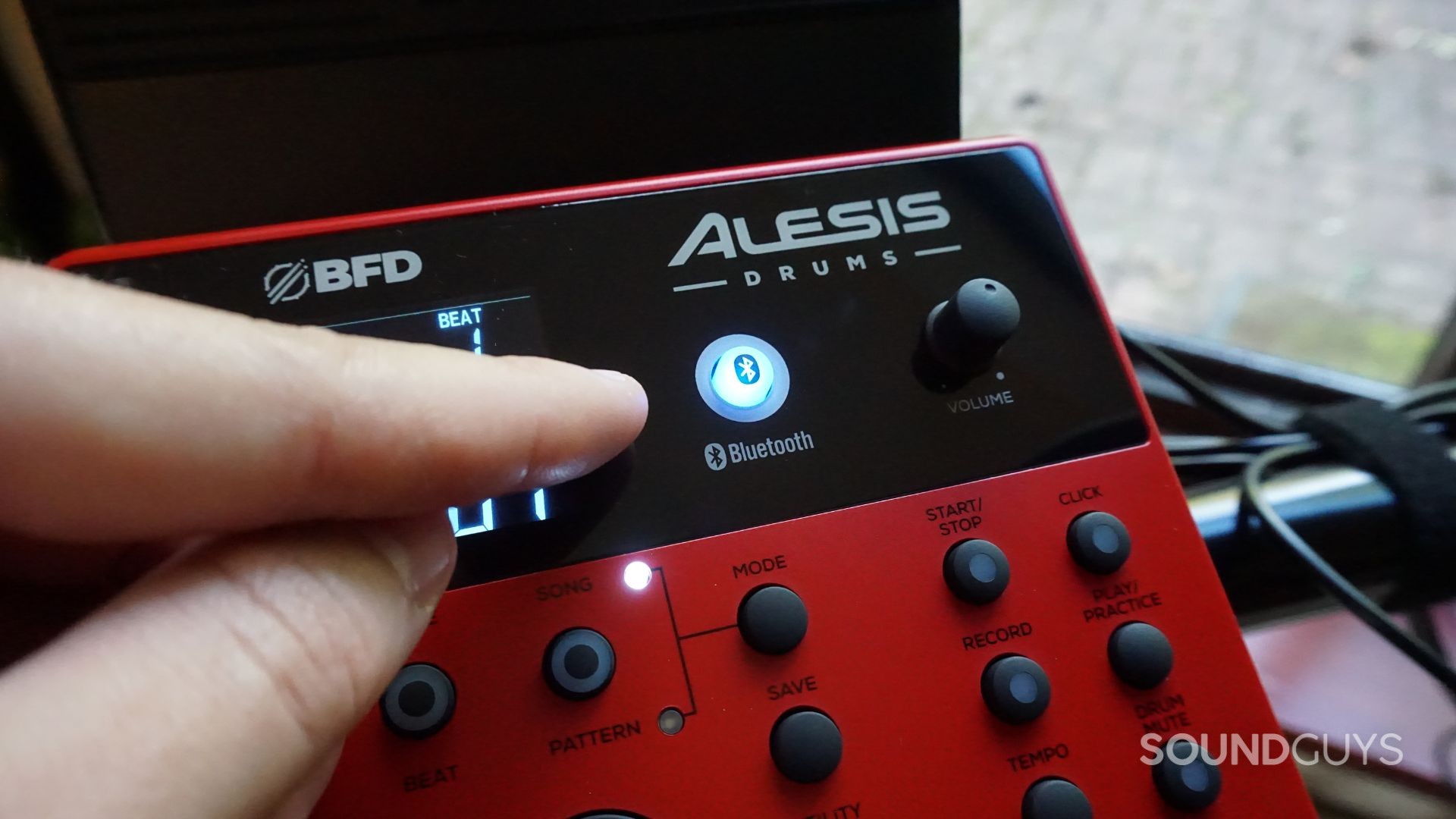All products featured are independently chosen by us. However, SoundGuys may receive a commission on orders placed through its retail links. See our ethics statement.

Alesis Nitro Ultimate review: The moving hi-hat is a step in the right direction
October 31, 2025
Alesis Nitro Ultimate
Weight: 21,300.0g
Alesis has just released the Nitro Ultimate electronic drum kit. Packed with learning features and a comprehensive sound library, it sits firmly at the top of the company’s mid-tier Nitro series. I put the kit through the ringer to see whether drummers receive all the necessary features for practice, live performance, and recording in 2025. Is it worth the upgrade from earlier siblings and cheaper alternatives, or does the kit fall short of the mark? Find out in our Alesis Nitro Ultimate review.
This article was published on TKTK, and this is the first version of the article. Updates will follow as the market changes.
What I like about the Alesis Nitro Ultimate

The Alesis Nitro Ultimate is a 5-piece e-kit that feels sturdy and well-built. The steel crossbars and support posts lock together easily and exhibit minimal vibration or movement when the kit is struck hard. Unboxing to full assembly took approximately two hours, but that includes time for fine adjustments and tidying loose wires away with the included cable ties. Just be mindful that the box it arrives in weighs a relatively hefty 21300g — you may need some help if you live upstairs.
Like other Alesis e-kits, the Nitro Ultimate uses arched crossbars to mount the drums and cymbals onto. This helps to emulate the semi-circular layout of acoustic kit setups, and it works well. The 10-inch dual-zone snare drum feels pleasing in the hand and features six tension rods for tuning adjustments. Likewise, the three 8-inch dual-zone toms adorn the same appealing ruby red lacquer exterior, and each has four tension rods. The kit ships with a drum key and all of the relevant clamps and L-Rods to refine your setup. Overall, the e-toms have a premium feel and a well-rounded finish that most people will enjoy.
The kick drum tower is wide enough to accommodate double kick pedals.
Unlike cheaper models, such as the Alesis Turbo Mesh, the Nitro Ultimate includes an 8-inch kick drum tower and single-chain kick pedal. The former is wide enough to accommodate double kick pedals, while the latter feels good underfoot. I had to make very minimal adjustments to the pedal spring out of the box, and the flat felt beater should work well enough for most players. You also now receive a moving hi-hat, and all the cymbals support choke functionality. The kit ships with a pair of maple, 5B-style, acorn-tipped drumsticks. They’ll do the job for beginners, but I quickly swapped them out for my trusty Vic Firth 5a American Hickory sticks.
The Alesis Nitro Ultimate drum module is the brain behind the brawn. This features 36 factory drum kits, 645 kit voices, 60 built-in songs, and space for 16 user-generated kits. You can navigate to each of these by using the series of buttons on the front panel and reading the prompts from the backlit segment LCD screen. There are also settings for adjusting pad sensitivity, threshold, crosstalk, velocity curve, and more under the Utilities settings menu.

All of the drum pads (bar the second crash cymbal, but more on that later) connect to the drum module using the trigger cable snake. However, the back panel also features two 1/4-inch TRS trigger inputs, 1/4-inch TRS mono and stereo outputs, a USB-B MIDI port, and a 1/8-inch TRS AUX input for external devices. Mercifully, the drum module also supports wired headphones through the “Phones” port located on the side panel. The jack is not immediately obvious upon first inspection, but it is handy for those who enjoy silent practice.
Bluetooth 5.0 is one of the drum module’s standout features for wireless audio enthusiasts. You can enable this by pressing the Bluetooth button on the front panel until it lights up blue. This makes the kit discoverable to nearby devices such as smartphones, tablets, and laptops. Once connected, you can stream music directly to the kit and jam along to your favorite songs. The drum module even features a mobile device shelf for storing your external device whilst you play. Just ensure your device is placed horizontally to avoid accidental slips or falls.
What I don’t like about the Alesis Nitro Ultimate

Despite its merits, the Alesis Nitro Ultimate has some notable foibles. For starters, the floor tom is small at eight inches, the ride does not have a physical bell, and the cymbals feel significantly flimsier than the mounted toms, especially on the non-rubberized side. This can be a particular problem for the 10-inch hi-hat, given how common it is for pull rods to rotate during play. Accidentally striking the rear side not only produces a shrill cracking sound but can also unintentionally damage the cymbal and trigger. Other, more premium kits, such as the Alesis Strata Club, have much more resilient, all-encompassing rubber cymbals.
Another issue is that, while the cymbals are technically dual-zone, they do not support multiple MIDI note-on/note-off messages. For example, you can strike the edge and the bow of the ride cymbal to produce a regular cymbal hit sound or a ride bell sound, respectively. However, striking the bow of the cymbal when recording MIDI does not create a separate MIDI note in your DAW. Instead, both the cymbal edge and cymbal bow will be recorded as MIDI note number 51 by default.
The drum module has many features but can be difficult to navigate.
I also encountered minor issues when assembling the kit. For example, the included 1/4-inch TRS trigger cable is only just long enough to reach between the second crash cymbal and the module once tied to the kit’s frame. Over time, this minimal slack could lead to a faulty connection, resulting in intermittent cracking and popping sounds. The quick assembly guide is also frustratingly vague — it took me several minutes to realize that the snare drum trigger output is located underneath the drum shell. This runs contrary to the toms and should really be explained in the guide.
You may be disappointed if you were hoping to start playing the Alesis Nitro Ultimate right out of the box. For example, the kit does not ship with a hi-hat stand or drum throne. Unlike cheaper rivals, such as the Donner DED-200, the kit also does not include headphones or an amplifier for audio playback. The company has launched a new floor monitor called the Alesis Nitro Amp Pro. However, this is currently unavailable in the U.S. You’ll also need to purchase your own USB and 1/4-inch TRS cables to record MIDI, mono, or stereo directly from the drum module.

Alesis upgraded the sound library of the Nitro Ultimate drum module. However, I found it less intuitive to use than rival brands and other Alesis kits. Perhaps I’m spoiled by having fallen in love with the 7-inch touchscreen of the Alesis Strata Club? Regardless, the module’s small LED screen only displays three characters when navigating the settings menu. This makes it trickier to understand which parameter you’re adjusting. For example, song volumes are shown as “ACC,” kit volumes as “DRM,” and hi-hat splash sensitivity as “S-S”.
I also had difficulty using the kit’s built-in lessons. This is enabled by pressing the Mode button to switch from “Normal Mode” to “Learning Mode”. Once selected, you can jam along to over 42 beats, rhythms, and patterns of varying difficulty. However, as there are no visual or physical prompts, this relies purely on aural learning. You can decrease the tempo to match your ability, but it is still hard to differentiate between different kit voices. This is particularly true when learning higher-level, whole-kit patterns. You can record your takes and receive a score to see how accurately you performed, but, in honesty, the learning feature feels more like a game than a way to expand your rhythmic repertoire.
The drum module lacks separate volume dials for the stereo output and headphones port.
Another frustration is that the drum module’s volume dial affects the stereo output and the headphones port simultaneously. This means that when recording with the stereo output, you cannot adjust the headphone volume separately without also affecting the stereo output level. Additionally, the song and kit volume adjustments are not saved when you power down the kit. So, if you’ve found a volume balance you enjoy, you’ll have to search for it again when you switch the kit back on.
The Nitro Ultimate comes equipped with a basic reverb and a 3-band EQ for dialing low, mid, and high frequencies. However, adjusting these also affects any songs you stream from the drum module. This seems like an odd design choice, given that it is much more common to EQ and apply reverb effects solely to individual kit voices. Considering the assembly guide is so vague, you’ll need to refer to the comprehensive online user guide to fully understand the module’s velocity curves, MIDI map, and kit voices.
How does the Alesis Nitro Ultimate sound?

The Alesis Nitro Ultimate has a sample library that should appease the average beginner and intermediate player. However, you may be disappointed if you plan to use this drum kit in professional settings. While some of the included samples exhibit nuances you’d expect to hear from acoustic drums and cymbals, others fall short of the mark. For example, the Standard 1 factory kit has noticeably synthetic-sounding toms. Similarly, many of the Nitro Ultimate’s samples produce the “machine gun” effect. This is caused by identical-sounding drum samples played in rapid succession. Rimshots and cross-sticks are also significantly quieter across the board. This can be adjusted in the drum module’s settings menu, but it’s an extra layer of inconvenience.
Below are four recordings of the same groove. These were played using the Deep Rock, Tight Pop, Garage, and Funk 1 factory kits. I recorded each sample in stereo using the two 1/4-inch (6.35mm) outputs on the module’s back panel.
Alesis Nitro Ultimate Deep Rock kit sample
Alesis Nitro Ultimate Tight Pop kit sample
Alesis Nitro Ultimate Garage kit sample
Alesis Nitro Ultimate Funk 1 kit sample
I left the Nitro Ultimate’s panning parameters unchanged to demonstrate the kit’s default panning. For reference, the kick and snare are set to 0, the hi-hat is set to -3, the high tom is set to -1, the mid tom is set to 1, the floor tom is set to 2, crash one is set to -2, the ride is set to 2, and crash two is set to 1.
Alesis Nitro Ultimate specs
| Alesis Nitro Ultimate | |
|---|---|
Size | 1219 x 1270 x 1016 mm |
Weight | 21300g |
Connection | Wired Wireless |
Controls | Buttons Knobs |
Audio inputs | 3.5mm AUX |
Audio outputs | 6.35mm mono 6.35mm stereo 3.5mm phones USB MIDI |
Wireless audio connection | Bluetooth 5.0 |
Connector | DC9V |
Price | $899 |
Should you buy the Alesis Nitro Ultimate?

The Alesis Nitro Ultimate ($899 at Amazon) is a decent midrange electronic drum kit with meaningful upgrades on its older siblings. Specifically, the moving hi-hat control is significantly more realistic than its predecessor’s static hi-hat. It also enjoys a broader sound library and 20 assignable non-drum samples for experimentalists. Bluetooth connectivity is a standout feature for wireless audio enthusiasts, and the MIDI connectivity is handy for home recordists. Alesis also includes its own desktop VST software with sounds from the kit’s BFD library. The structure is sturdy, the finish is striking, and the built-in lessons will be useful for learners with good aural skills. The kit also includes a 90-day subscription to Drumeo, providing access to courses and unique artist content.
However, the kit has a reasonably high price tag for what you get. The lack of a hi-hat stand, drum throne, audio cables, and monitoring accessories means that your overall startup costs may easily exceed $1500. Given the price, I’d have preferred stacked samples for minimal machine-gunning, a triple-zone ride cymbal with bell, a more intuitive drum module, and a larger floor tom.

Rivals kits, like the Millenium MPS-750X Pro, offer exceptional value for those outside the US. Even then, the kit’s realistic size, mesh pads, and rubber cymbals may be worth paying the additional import costs. For the money, you receive real wood shells, all the relevant hardware (including a hi-hat stand), and dual- and triple-zone cymbals. The last is supported by the ride cymbal, which, unlike the Alesis Nitro Ultimate, has a bell. The drum module also features separate stereo output and headphone volume dials. There are pad-specific sliders, 700 samples, 20 factory kits, and space to save 20 user kits. Like the Nitro Ultimate, the MPS-750X Pro supports Bluetooth audio streaming and USB connectivity for easy at-home recording.
If you have the extra cash, it may be worth investing in the Roland TD17-KVX2 ($1699.99 at Amazon). While this also does not ship with a hi-hat stand or a kick pedal, the cymbals and drums feel significantly more premium. The 12-inch double-mesh snare is a particular highlight, and the drum module comes with high-quality Prismatic Sound Model samples and features. These include separate sounds for cymbal edges, bows, bells, and the kit produces nuanced cross-sticks and dynamic rimshots. The TD17-KVX2’s Coach Mode is ideal for learners and provides daily practice regimens, recording capabilities, and methods for improving your timing. Bluetooth audio is also supported, and the trigger inputs allow for additional kit expansions.
Alesis Nitro Ultimate review: FAQs
The Alesis Nitro Ultimate is a decent option for beginners and intermediates. The kit feels robust, supports learning features, and includes a moving hi-hat. However, some of the samples produce the machine-gunning effect, and the drum module is relatively unintuitive. Nevertheless, it earns a recommendation for those looking for a reliable practice kit before investing in acoustic or high-end electric options.
Yes, the Alesis Nitro Ultimate supports wireless audio streaming via Bluetooth 5.0.
Yes, the Alesis Nitro Ultimate is a good option for beginners. It's packed with aural learning features, has ample built-in sounds, and plays nicely overall. However, it does not ship with a hi-hat stand, drum throne, audio cables, or monitoring accessories. Consequently, you may wish to explore cheaper alternatives with more hardware included out of the box.
The Alesis Nitro Ultimate undercuts most of Roland's mid-tier electronic drum kits. Likewise, it ships with a desirable moving hi-hat instead of the static control of Roland's similarly priced alternatives. However, many of Roland's kits have better-sounding samples baked in, and spending a little more can reward cymbals with more intuitive trigger zones. Ultimately, it's a toss-up between costs and features.
Thank you for being part of our community. Read our Comment Policy before posting.